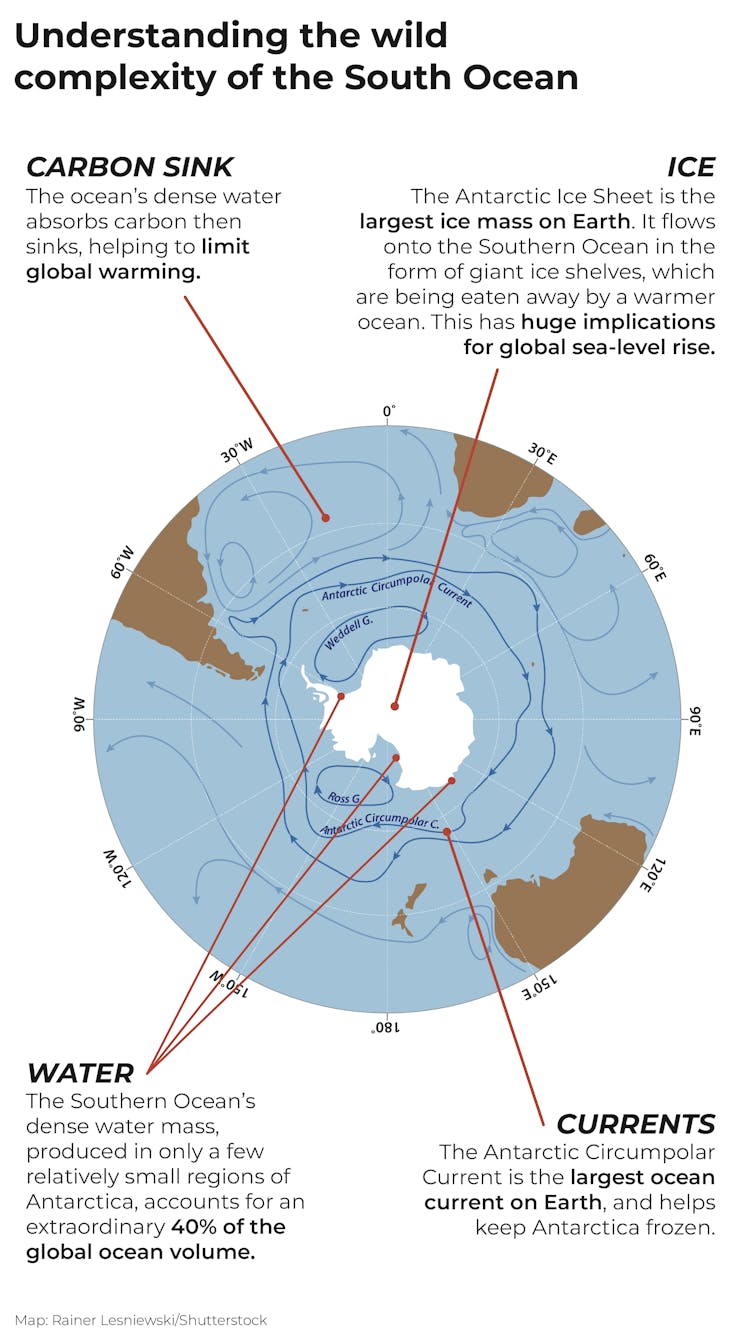here’s why the Southern Ocean is a global engine room
- Written by Luke Bennetts, Lecturer in applied mathematics, University of Adelaide

The Southern Ocean is wild and dynamic. It experiences Earth’s strongest winds and largest waves. It is home to city-sized icebergs and the biggest ocean current on the globe, as well as tiny turbulent flows that fit inside a teacup.
The Southern Ocean is also crucial to Earth’s natural systems. It forms the dense water that fills the world’s deep oceans. It stores heat and carbon resulting from human-caused global warming, and controls the flux of heat to the huge ice sheet of Antarctica – the greatest threat to runaway global sea-level rise.
The scale and complexity of the Southern Ocean can be hard to comprehend. But our new paper may help. It summarises the present state of understanding of the Southern Ocean, how it is changing, and where the knowledge gaps lie.
Scientists and others regularly voyage to the Southern Ocean’s furthermost icy reaches – but more research is needed. The scientific and broader community must join together to advance Southern Ocean science and protect this vital natural asset.
Masses of ice at risk
The Antarctic Ice Sheet is the largest ice mass on Earth, equivalent to 58 metres of the global sea level.
The ice sheet flows onto the Southern Ocean surface in the form of giant ice shelves. Many of these ice shelves are being eaten away from below by a warmer ocean, or crumbling and becoming icebergs at a faster rate than before.
Beyond the ice shelves, millions of square kilometres of the Southern Ocean surface is frozen into a layer of sea ice. This acts as a giant solar reflector and shields ice shelves from powerful Southern Ocean waves.
After decades of seemingly defying warming temperatures, the Southern Ocean’s sea ice has dramatically declined in recent years. This puts ice shelves and the ice sheet under even greater stress.
Filling Earth’s oceans
Much of the sea ice is produced in small regions of open water, called “polynyas”, formed by strong and cold winds blowing off Antarctica. These winds cool the ocean surface below the freezing point, causing ice to form.
As the ice forms it ejects salt into the ocean surface. This extra salt, in addition to cooling effects from the atmosphere, makes the surface seawater heavier, or more “dense”.
The dense water sinks in turbulent plumes (imagine an upside-down volcano) and cascades through underwater canyons into the deep ocean, while mixing with overlying waters.
The resulting dense water mass, produced in only a few relatively small regions of Antarctica, accounts for an extraordinary 40% of the global ocean volume. It is ultimately lifted back to the ocean surface by centimetre-scale turbulent eddies – of the type you see when mixing milk into your tea.
In the deep ocean, this mixing is largely driven by ocean tides that slosh over the rough seafloor and produce internal waves.





